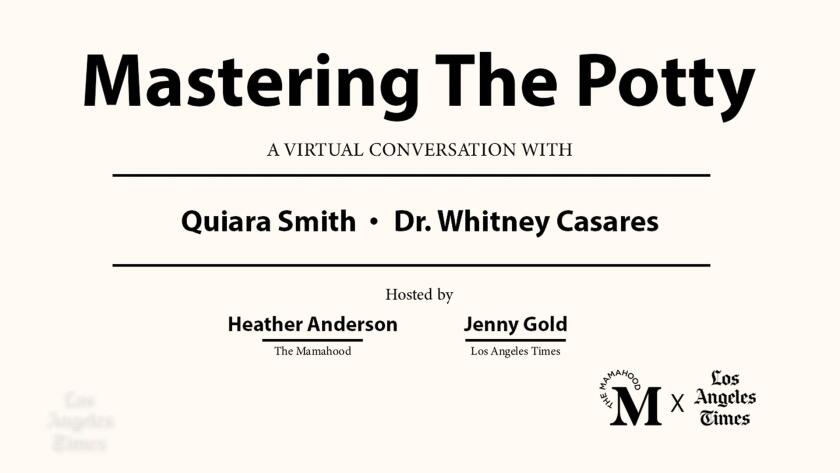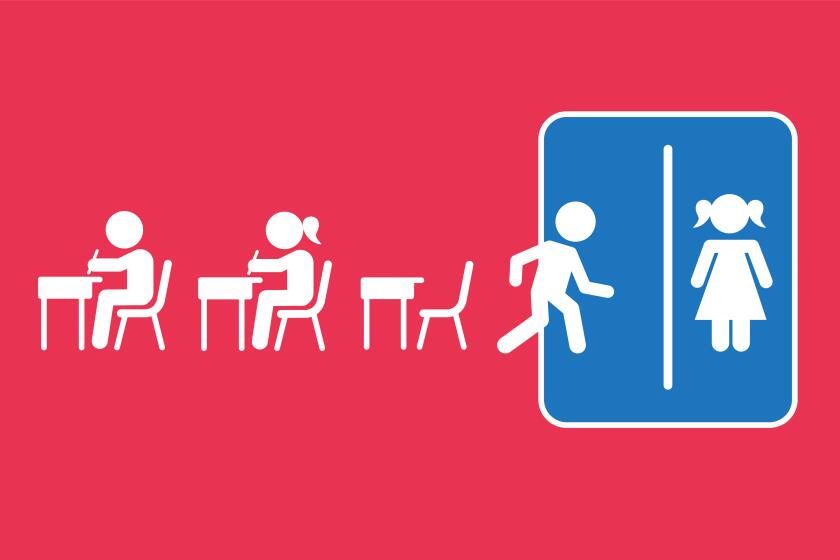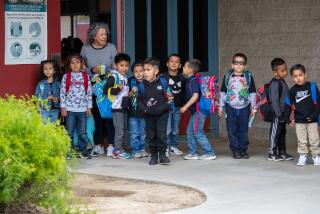Is your child struggling to master the potty? These 5 takeaways from our panel can help
- Share via
- Share via
Potty training isn’t easy and it can vary a lot from child to child. The L.A. Times spoke with experts about how parents can best navigate this chapter, how they can prepare their child for a new level of independence and how they can tell that it’s actually time to start.
Here are five takeaways from a discussion among Jenny Gold, L.A. Times early childhood reporter; Heather Anderson, administrator of the Mamahood Facebook group; Whitney Casares, Modern Mommy Doc founder and pediatrician; and Quiara Smith, CEO of Aloha Integrative Therapy and occupational therapist. They spoke to the Mamahood Facebook group.
Let your child’s development dictate when you begin to potty train.
Children will generally be ready to potty train between 2 and 3 years old, but there are also individual developmental factors that come into play. You should make sure your child is able to physically sit on the toilet, has the desire to go to the bathroom and can communicate with you that they need to go, Casares said.
A child needs to understand what it feels like when their bladder is full, Smith added. They need to be able to link that feeling to control over the necessary muscles, which is dependent on their development.
It’s important to choose potty-training methods that suit your child’s needs. Casares recommends starting with the three-day method, which recommends parents commit to leaving their child naked from the waist down for three days, while having them drink lots of liquids and encouraging them to use the bathroom every 15 minutes. It’s meant to teach kids to grow more in tune with their body’s cues. From there, adapt to your child’s needs as you see fit, she said.
Choose a time to potty train when you can be present with your child and can observe whether they are resisting your chosen method, so that you can adapt, Casares said. You might find success by introducing a rewards chart, for example.
You’ll want to demonstrate flexibility, patience and understanding.
You can encourage your child to learn even when they aren’t quite ready to start
You can help grow interest in potty training concepts early on through play, books and songs. Some kids might show curiosity before they’re ready to start. It’s OK to indulge them and bring out a kid’s potty, Casares said, but don’t start the training until they have the skills to do it.
Help them learn about their bodies in a playful manner. Draw pictures of the body with them. Explain what it is and why it’s happening. It’s important to remember your child is absorbing all the information and looking for you to guide them, she added.
Establish a fiber-rich diet early on so that your child can develop bowel regularity. Feed them leafy greens and as well as fruits and vegetables. And make sure they’re staying hydrated as well so that the fiber can take effect. It’ll help them avoid problems with pooping and constipation when they start potty training.
Find ways to make public bathrooms more comfortable both at school and beyond.
Public bathrooms can be intimidating. Loud noises, bright lights and funny smells can make your child nervous, especially if they deal with sensory processing issues. With the expansion of California’s transitional kindergarten, kids are starting school younger and without the same bathroom support they may have had at a preschool.
California’s 4-year-olds are entering transitional kindergarten. But many young learners aren’t fully potty-trained, an issue public schools are grappling with.
Smith recommended creating a sensory bag for your child that can include items like sunglasses if your child is sensitive to the bathroom’s bright lights, noise-canceling headphones if they’re scared of the flush and smelly hand sanitizer that they can spray to mask the bathroom smell. If your child is scared of automatic flushing, you can also cover the automatic flush sensors with a sticky note so as to not catch them by surprise, Smith said.
If your child deals with anxiety or sensory issues, Casares recommends teaching your child to make a “nest” out of toilet paper to cover the toilet seat. As they transition to using a bathroom outside of their home, it might bring your child comfort to have a similar surface to sit on no matter where they go.
If your child needs assistance going to the bathroom at school, parents can request accommodations through a 504 Plan, which dictates how a school can support a student with disabilities in the classroom. The plan can provide extra time in the bathroom or allow for an aide to assist with wiping or in modifying lighting and sounds in the bathroom.
Help your child understand concepts involved with going to the bathroom
Teach them to wipe surfaces around the house to get them to understand that the point of wiping is to clean. They can wipe a counter or a window, for example. Then transition to on-body wiping. You can put soap on their arm in the bath and have them wipe it off, Smith suggested. Once they start wiping themselves, help them learn the movement by wiping with your hand over theirs using either a wet wipe or toilet paper.
These practices will help them develop the fine motor control they need to do it on their own, Smith said. Though the task might seem small, don’t forget that it takes lots of coordination, range of motion, strength and balance to perform.
Being away from a familiar space like home might also add a bit of anxiety, so it’s important to give your child the practice and resources they need to succeed under the pressure.
Public schools want children to be fully potty-trained when they enter transitional kindergarten. Use these resources to help them develop their independence.
Potty training can take time. Assess what’s working and what isn’t.
Don’t sweat it if your child has mastered some aspects of potty training but is struggling with others. Some days might feel less productive, and that’s normal.
If your child is scared to potty train, talk to them about why. Validate their feelings and let their answers help you problem-solve. Have them drink more water or eat more vegetables and create a more calming environment.
Understand what factors might be affecting their progress. If your child is successfully peeing in the potty, but is struggling to poop, lots of times it’s because they’ve been dealing with constipation since infancy, Smith said. They might not trust the sensation and withhold it, in turn causing more constipation. It’s often a trauma imprint, she explained.
If you’re worried that your child is still wetting the bed at night, know that it’s normal for many kids who are simply not developmentally ready to prevent accidents at night. It’s OK to still rely on pull-ups if you need to. Some kids may wet the bed until they reach puberty, Casares said.
This article is part of The Times’ early childhood education initiative, focusing on the learning and development of California children from birth to age 5. For more information about the initiative and its philanthropic funders, go to latimes.com/earlyed.
More to Read
Sign up for Essential California
The most important California stories and recommendations in your inbox every morning.
You may occasionally receive promotional content from the Los Angeles Times.















